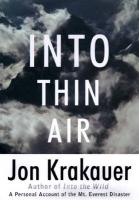
 Fifteen years ago in early May, several climbers lost their lives near the summit of Mt. Everest during an unexpected and brutal storm. Hampered visibility, oxygen deprivation, and a wind chill index of 100 degrees below zero prevented these climbers from returning to a lower base camp. Exposure, fatigue, misinformation, radio malfunctions, disorientation, sickness, and failed rescue attempts also contributed to the loss of life. Among the deceased were two prominent and seasoned guides, Rob Hall and Scott Fischer. Jon Krakauer, a survivor of Rob Hall’s expedition team, made it to the summit and back to camp prior to the worst part of the storm. Into Thin Air is Jon’s well written personal accounting of events that occurred during this expedition. It is a book to assist in bringing closure and perhaps answers to why events occurred as they did. The book includes details of his personal thoughts and actions, history of Mount Everest climbing, and his interactions with not only his expedition team members but others as well. If you are a mountain enthusiast, you will want to read this book.
Fifteen years ago in early May, several climbers lost their lives near the summit of Mt. Everest during an unexpected and brutal storm. Hampered visibility, oxygen deprivation, and a wind chill index of 100 degrees below zero prevented these climbers from returning to a lower base camp. Exposure, fatigue, misinformation, radio malfunctions, disorientation, sickness, and failed rescue attempts also contributed to the loss of life. Among the deceased were two prominent and seasoned guides, Rob Hall and Scott Fischer. Jon Krakauer, a survivor of Rob Hall’s expedition team, made it to the summit and back to camp prior to the worst part of the storm. Into Thin Air is Jon’s well written personal accounting of events that occurred during this expedition. It is a book to assist in bringing closure and perhaps answers to why events occurred as they did. The book includes details of his personal thoughts and actions, history of Mount Everest climbing, and his interactions with not only his expedition team members but others as well. If you are a mountain enthusiast, you will want to read this book.
Mt. Everest is part of the Himalaya, a mountain range that runs between Tibet and Nepal. At 29028 feet above sea level, it rises above all other mountains. Quoted from the book, “A human plucked from sea level and dropped on the summit of Everest where the air holds only a third as much oxygen would lose consciousness within minutes and die soon thereafter.”
One might wonder why anyone would desire to climb to the top of the world knowing the risk. Reasons vary. I accepted risk even at a lower altitude in order to reach the summit of Pike’s Peak in Colorado. I wanted to see a panoramic view of the carved glacial valleys, experience what it was like to breathe the air at just over 14000 feet, and be at the highest point on earth I had ever been. Finally, I hoped to share my experience with others.  A good reason to climb to the top of Mount Everest can be summarized by George Leigh Mallory’s quote, “Because it is there.”
A good reason to climb to the top of Mount Everest can be summarized by George Leigh Mallory’s quote, “Because it is there.”
Jon Krakauer may have thought in hindsight that if he had done something different during his expedition, lives could have been saved. In reality, changing events may not have changed results in a favorable manner. Perhaps changing events or his actions would have made matters worse, creating more disastrous results and loss of life.
There is not one activity in life without risk. For those who respond to the mountains’ call for whatever reason(s) will never see the associated risk greater than the sought after reward. No two climbs are the same. Each climber experiences a unique inner satisfaction. “Because it is there,” is perhaps the best reason to climb.
You might also enjoy the IMAX movie, Everest, a McGillivray Freeman Film, that was filmed during the same time and referenced in the book. The movie is narrated by Liam Neeson and directed by David Breashears, Greg MacGillivray, and Stephen Judson. The movie includes the hit song, Here Comes The Sun, performed by George Harrison.
